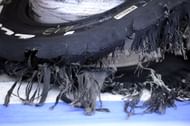Another potential reason could be the GP2 race held earlier. The GP2 series mostly follows the F1 calendar and conducts its races a few hours before F1. Normally, the track is cleaned of all debris and readied for the F1 race. But this time, could the marshals be at fault?
A dirty track to begin with is never a safe sign – could this be why Lewis suffered a tyre failure so early? The GP2 event has been following the F1 events for years, so why should these failures be happening now?

Ferrari’s Felipe Massa’s shredded tyre is seen in the pits at the Silverstone circuit during the British Grand Prix
The only reason we can think of in blaming GP2 rubber for causing the F1 mayhem could not be the GP2 race itself, but the marshals cleaning up the race track during the preparation of the F1 race. I know they are the unsung heroes of motorsport, always at hand in all weather conditions and during any accident, but this time, they may be slightly at fault.
Weighing up these three reasons, I feel that Pirelli is more at fault than the others. Simply a really dirty track or a single kerb cannot explain four left rear tyres exploding without warning.
The problem calls for an immediate solution since the German Grand Prix at the Nurbergring is only a week away. A meeting has already been scheduled for Wednesday and one can only hope that a safe solution is found. One of the suggestions put forth so far include using last season’s tyres for this weekend’s race, or possibly beyond that till Pirelli get their act together.
But such a big change will be hamper the progress made by some teams like the Torro Rosso and Mercedes who are working better on this year’s tyres, while teams like Red Bull will be happy to use the tyres on which they clinched both championships last season. The tyre change mid-season could result in affecting the World Championship, and there will again be controversy.
If Pirelli pull out of the sport altogether, what are the options? Convincing Michelin, Bridgestone, or Goodyear to make a comeback? Or could another company enter the fray? Hard to see any of the above happening.
But what if teams approach tyre manufacturers on their own? Will FIA decide to allow teams to choose their own tyre manufacturers? That is, can FIA pull out from having a say in choosing tyre manufacturers? Then, it is up to the teams to choose their supplier.
This will make the situation more interesting. Some tyres may wear out faster but perform better, some may have a better life than others. Before the weekend commences, the FIA can verify if the tyres being used by each team are in accordance with the rules.
Now, in case of failure, the teams can fight it out with their manufacturer or simply approach another party. Then, people like Cristian Horner or Ross Brawn would have another aspect to think about – choosing their tyre supplier, in addition to the other successful choices they usually make.
Summary
Pirelli came into F1 in a tricky situation where refuelling had just been banned, and the FIA demanded them to make quicker wearing tyres. So far, they have done a decent job in playing to the FIA’s tunes. But in the aftermath of this British Grand Prix fiasco, they may have realized that they have taken a step too far.
Safety of drivers is of primary importance, and we can only hope that Pirelli, FIA, and the teams reach a decision this week and make the sport a lot safer than what we have just witnessed.